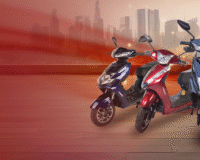Electric scooters (EVs) have taken the world by storm, revolutionizing the way we commute and contributing to a greener planet. Yet, despite their growing popularity, misconceptions about EVs still persist. These myths often prevent people from making the switch to electric, depriving them of the numerous benefits EVs offer. In this blog, we’ll debunk some of the most common myths about electric scooters and set the record straight.
Myth 1: Electric Scooters Are Too Expensive
One of the most widespread misconceptions is that electric scooters are prohibitively expensive. While the initial purchase price of an EV might be higher than a petrol scooter, the long-term savings are significant. EVs have lower running costs since they don’t require fuel – electricity is much cheaper than petrol. Additionally, maintenance costs are drastically reduced because EVs have fewer moving parts compared to traditional scooters.
Moreover, governments across the globe, including India, offer attractive subsidies and tax benefits for purchasing electric vehicles. These incentives can significantly reduce the upfront cost, making EVs an affordable option for many.
Myth 2: Electric Scooters Don’t Have Enough Range
“Range anxiety” is a term often associated with EVs, but modern electric scooters are breaking this stereotype. Today’s electric scooters offer impressive ranges, with many models easily covering 70-150 kilometers on a single charge. This is more than sufficient for most daily commutes in urban and suburban areas.
For instance, brands like e-Sprinto have developed scooters such as Amery and Sprinto HS equipped with advanced battery technology, ensuring riders don’t have to worry about running out of charge mid-journey. Additionally, the growing network of charging stations across cities is further alleviating range concerns.
Myth 3: Charging Takes Too Long
Another common misconception is that EVs take an eternity to charge. While it’s true that early models had longer charging times, advancements in technology have drastically reduced this issue. Modern electric scooters now come with fast-charging options that can power up a scooter in just 1-3 hours. Even without fast charging, most scooters can be fully charged overnight, making it convenient for daily use.
For those who need a quick top-up, some EV models also offer swappable batteries, allowing users to simply replace a depleted battery with a fully charged one in minutes.
Myth 4: Electric Scooters Lack Power and Speed
Many people believe that electric scooters are slow and lack the power needed for efficient commuting. This couldn’t be further from the truth. Today’s EVs are designed to deliver robust performance, with some models rivaling or even surpassing petrol scooters in terms of acceleration and top speed.
For example, e-Sprinto’s high-speed scooters are engineered for a perfect balance between speed, torque, and battery efficiency, ensuring a smooth and powerful ride. Whether it’s climbing steep inclines or navigating busy city roads, modern electric scooters are more than capable of meeting the challenge.
Myth 5: Electric Scooters Aren’t Reliable
Reliability is a concern for many first-time EV buyers, but modern electric scooters are built to last. With fewer mechanical components, EVs are less prone to wear and tear compared to traditional petrol scooters.
Manufacturers like e-Sprinto also prioritize quality, offering warranties and strong after-sales support to ensure a hassle-free ownership experience. Additionally, regular software updates and diagnostics enhance the reliability of electric scooters, making them a dependable choice for daily commuting.
Myth 6: EVs Are Bad for the Environment Due to Battery Production
While it’s true that battery production has an environmental impact, studies show that the overall carbon footprint of an electric vehicle is significantly lower than that of a petrol vehicle over its lifetime. EVs produce zero tailpipe emissions, which drastically reduces air pollution in cities. Additionally, advancements in battery recycling and the shift toward renewable energy for electricity generation are further minimizing the environmental impact of EVs.
Myth 7: There Aren’t Enough Charging Stations
A lack of charging infrastructure is often cited as a reason to avoid electric scooters. However, this is rapidly changing. Governments and private companies are investing heavily in building a widespread network of charging stations. In India, for example, cities like Delhi, Bangalore, and Pune are witnessing a surge in charging points, making it easier than ever to own and operate an EV.
Moreover, the convenience of charging at home is a game-changer for EV owners. Many users find it more practical to plug in their scooter overnight, eliminating the need to visit a charging station altogether.
Conclusion: Time to Embrace the Electric Future
Electric scooters have come a long way, debunking myths and proving themselves as reliable, efficient, and eco-friendly alternatives to traditional petrol scooters. By making the switch, you’re not just saving money but also contributing to a cleaner, greener planet.
Brands like e-Sprinto are at the forefront of this electric revolution, offering innovative and affordable solutions tailored to modern commuters. So, don’t let myths hold you back—it’s time to embrace the electric future, one ride at a time.






